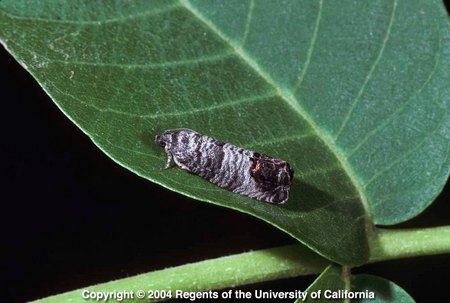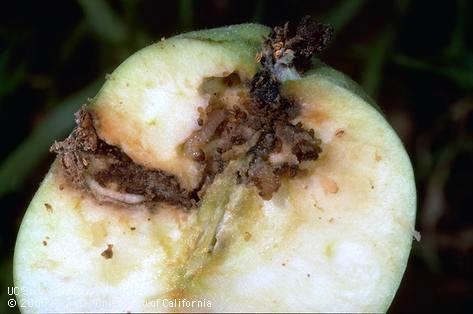If you have a history of “worms” in your apples, pears, or English walnuts, and have felt perplexed as to how to manage this problem, the very first step is to understand what is happening. When one understands that, the management becomes more understandable and approachable.
The “worms” are actually caterpillars, the immature stage of an adult moth. The life cycle is egg, larva (caterpillar), pupa, adult. The adult moth is mottled gray and small (½ to ¾ inch) and therefore hard to see and often goes unnoticed.
The adult female moth lays her eggs on or near developing fruit. The egg hatches and the caterpillar immediately will chew its way into the fruit where it lives and feeds. Entry holes are referred to as “stings” and typically exhibit a sawdust like residue called “frass”. If one sees a sting, the larva has already entered the fruit and is impervious to insecticidal sprays.
When it is ready to pupate, it will chew its way out and drop to the ground where it pupates in soil or leaf debris or under tree bark. After pupation an adult emerges and starts the cycle all over again.
The rate of development varies with temperature, proceeding more rapidly in warmer weather and climates. Depending upon the climate, codling moths can have two, three, and sometimes four generations per year. Our county has warmer climates inland and cooler climates by the coast. This means adult moths will start flying sooner and have more generations in the warmer areas and start flying later and have fewer generations in the cooler areas. Adult moths can start flying and laying eggs as early as March. The link below shows the approximate timing of the multiple generations.
https://ipm.ucanr.edu/PMG/PESTNOTES/pni7412-3.html
Codling moths can be difficult to manage, and a goal of 100% undamaged fruit may be unrealistic. A more reasonable goal would be to harvest enough undamaged fruit to meet your needs. In most backyard situations, the best course of action would be to combine a variety of the following non-chemical and low toxicity chemical methods early in the season.
Non-chemical:
- Pheromone traps (sticky traps laced with female pheromone to attract males) are not an effective management approach by themselves. They may be helpful if multiple traps are placed in a tree, but primarily they are used to monitor when adults are flying in order to time chemical applications. Traps can be purchased at most home and garden stores or online.
- Thinning your crop is important. The moths are most attracted to the place where two apples touch. Four to eight weeks after bloom, thin the fruit to only one per cluster, about every 6 inches.
- If you have thinned your fruit you may want to go one step further by “bagging” it. Although tedious and time consuming, placing bags over individual fruits early in the season, when the fruit is ½ to 1 inch in diameter, provides excellent control. The bag could be paper or cotton string. The link below provides a drawing of the bagging process. https://ipm.ucanr.edu/PMG/PESTNOTES/pni7412-2.html
- Beginning about six to eight weeks after bloom, and continuing every week or two throughout the season, check fruit on the tree for signs of damage (stings). Remove and destroy any infested fruit. Do not put the culled fruit in your backyard composting system, rather place it in green waste so it gets removed from your property.
- Since pupation takes place in litter on ground under the tree, keep the area continuously clean throughout the season, even though winter.
Low toxicity chemicals:
- CYD-X is a biological insecticide, a granulosis virus that affects only codling moth caterpillars. It kills by ingestion, therefore it must be ingested by the caterpillar prior to or as entering the fruit. To achieve this, it needs to be applied weekly beginning at the time of egg hatch. CYD-X is primarily available online.
- Spinosad is a biological insecticide, a bacterium that is toxic to insects in general. It kills by both contact and ingestion, therefore it needs to be applied at 10-day intervals beginning at the time of egg hatch. Spinosad is readily available at most home and garden stores.
- Adding 1% horticultural oil to either of the above improves effectiveness.
- Identifying the timing of egg hatch is key to the success of chemical applications. Egg hatch can be estimated by visually monitoring first stings or by using the UC Degree Day Calculator for codling moth https://ipm.ucanr.edu/calludt.cgi/DDMODEL?MODEL=CM&CROP=landscape
It is important to begin implementing control measures early in the season. The link below to the UC Integrated Pest Management website provides the detailed information you will need for implementation of your codling moth management program.
https://ipm.ucanr.edu/PMG/PESTNOTES/pn7412.html
Photo credits: Three photos above: Copyright UC Regents - photographer Jack Kelly Clark
Help Desk of the UC Master Gardeners of Contra Costa County (EDC)


